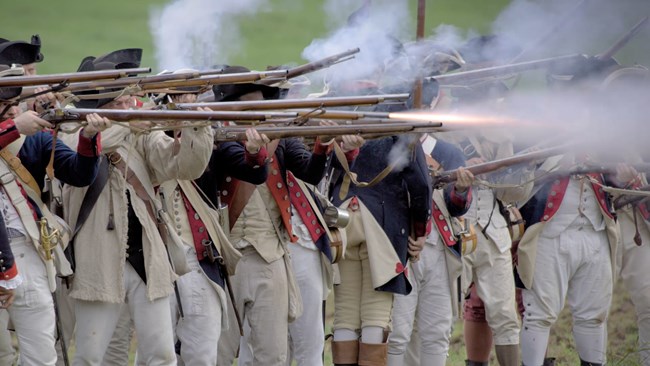Last updated: May 30, 2024
Article
French Alliance Day

NPS Image
Celebrating the Alliance
On May 5, 1778 General George Washington received news that France had formally recognized the United States and entered into a mutual defense pact with its new ally. To celebrate, the commander-in-chief freed condemned prisoners and ordered that extra rations of rum be distributed to the troops.

NPS Image
If you stood on the Grand Parade at Valley Forge the next day on May 6, 1778 at half past eleven o' clock, you would have heard the *rat-tat-tat* of celebratory musket fire and voices raised in cheer — Huzzah! Long live the King of France!
The Continental Army conducted a feu de joie (a.k.a. fire of joy)—a musket salute with each soldier firing in succession along the ranks. They cheered for the long life of both King Louis XVI (ironic, considering what would happen during France's revolution fifteen years later) and the "friendly European powers."
A Global Conflict
As empires, France and Britain claimed territory around the world. French entry into the war meant that Britain would have to divert troops and resources from Philadelphia to defend their other possessions.
Despite the advantages of a formal French alliance, Washington worried that Patriots might relapse into a false sense of security. The struggle for independence would continue for another five years.
Learn more about America's fight for independence from Great Britain.
1. “General Orders, 5 May 1778,” Founders Online, National Archives, https://founders.archives.gov/docu…/Washington/03-15-02-0039. [Original source: The Papers of George Washington, Revolutionary War Series, vol. 15, May–June 1778, ed. Edward G. Lengel. Charlottesville: University of Virginia Press, 2006, pp. 38–41.]
2. “From George Washington to Major General Alexander McDougall, 5 May 1778,” Founders Online, National Archives, https://founders.archives.gov/docu…/Washington/03-15-02-0043. [Original source: The Papers of George Washington, Revolutionary War Series, vol. 15, May–June 1778, ed. Edward G. Lengel. Charlottesville: University of Virginia Press, 2006, pp. 47–48.]
Tags
- fort stanwix national monument
- saratoga national historical park
- valley forge national historical park
- washington-rochambeau revolutionary route national historic trail
- yorktown battlefield part of colonial national historical park
- revolutionary war
- american revolution
- revolutionary war encampments
- valley forge
- valley forge national historic park
- french alliance
- cultural landscapes
